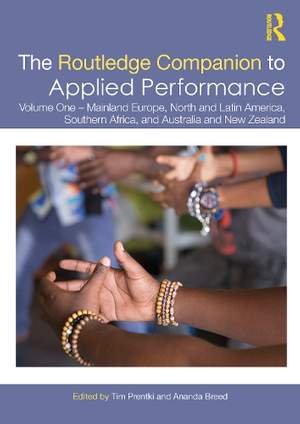
The Routledge Companion to Applied Performance: Volume One – Mainland Europe, North and Latin America, Southern Africa, and Australia and New Zealand
- Editor: Breed, Ananda
- Editor: Prentki, Tim
Book
$67.25Contents
- Introduction to Volume One;
- Part I : Australia and New Zealand;
- Introduction to
- Part I : ‘Considering the ethics of representation in applied theatre’. - Helen Cahill & Peter O’Connor;
- Chapter 1 : ‘Identifying and understanding the notion of quality within an applied theatre project designed to playfully engage people living with dementia’. Julie Dunn & Michael Balfour;
- Chapter 2 : ‘Repairing the evil: Staging Puppet Antigone (2017) at Auckland Prison’. - Rand Hazou;
- Chapter 3 : ‘Taurima Vibes: Economies of manaakitanga and care in Aotearoa New Zealand’. - Molly Mullen & B ō ni Te Rongopai Tukiwaho;
- Chapter 4 : ‘Small acts at the margins: Making theatre work at cross-cultural intersections’. - Linden Wilkinson;
- Chapter 5 : ‘The art of listening in prison: Creating radio drama with incarcerated women’. - Sarah Woodland;
- Part II : The Balkans;
- Introduction to
- Part II and III: ‘Memory, identity, and the (ab)use of representation’. - Kirsten Sadeghi-Yekta & Darko Lukić;
- Chapter 6 : ‘Performing the otherness: Representation of the invisible communities in post-conflict and post-communist societies: Croatian example’. - Darko Lukić;
- Chapter 7 : ‘The bridge to hope: Applied theatre in post-war Bosnia and Herzegovina’. - Sead Đulić;
- Chapter 8 : ‘Theatre against violence, action in classrooms’. - Ines Škuflić Horvat, Maja Sviben, & Nina Horvat;
- Chapter 9 : Interview with Vladimir Krušić: Theatre and drama in education. - Darko Lukić;
- Chapter 10 : ‘In search of polyphonic concepts of participatory theatre and art for social change: Almost half a century of engagement’. - Ljubica Beljanski-Ristić;
- Chapter 11 : ‘Giving voice to the voiceless: Raising awareness and spurring debate on the Homeland War (1991–1995) in Croatian theatre’. - Nikolina Židek;
- Part III : North America;
- Chapter 12 : ‘Examining the ethics of research-based theatre through Contact! Unload ’. - George Belliveau, Susan Cox, Jennica Nichols, Graham W. Lea & Christopher Cook;
- Chapter 13 : ‘We Are Here: Gylphing a re-creation story through waterways, bloodlines and constellations’. - Jill Carter;
- Chapter 14 : Applied performance practices of therapeutic clowns: A curated conversation with Helen Donnelly. - Julia Gray, Jenny Setchell, & Helen Donnelly;
- Chapter 15 : ‘Playback Theater conductor as ritual guide: The artful and sensitive job of extracting personal stories’. - Hannah Fox;
- Chapter 16 : ‘Theatre to address social justice issues with gatekeepers in Canada’. - Lauren Jerke & Warwick Dobson;
- Chapter 17 : ‘Tensions of engagement: Oscillating between distance and implication’. - Yasmine Kandil;
- Chapter 18 : ‘Questioning social justice: A dialogue on performance, activism and being in-between’. - Asif Majid & Elena Velasco;
- Chapter 19 : ‘Timely homecomings’. - Carrie MacLeod;
- Chapter 20 : ‘The arrivals legacy process: Reviving Ancestral stories of recovery and return’. - Diane Roberts;
- Chapter 21 : ‘Applying Hamilton ’ - Hana Worthen;
- Part IV : Latin America;
- Introduction to
- Part IV : Applied performance in Latin America. - Paloma Carpio & Rodrigo Benza;
- Chapter 22 : ‘The body, women, and performance art in Latin America’. - Josefina Alcázar;
- Chapter 23 : ‘Dance as a tool for the construction of peace and identity’. - Ana Carolina Ávila;
- Chapter 24 : ‘We play as we mean to resist: Theatre games as political participation’. - Matthew Elliott;
- Chapter 25 : ‘Communal living culture: From the many to the few, from the few to the many’. - Iván Nogales & Paloma Carpio;
- Chapter 26 : ‘Latent conflict or latency in conflict: The liminal space between art actions and the Chilean civic-military dictatorship’. - Andrés Grumann Sölter & Francisco Gonzáles Castro;
- Chapter 27 : ‘The community and its Gaze: Argentine community theater’. - Edith Scher;
- Chapter 28 : ‘Three community experiences and a resignation’ - Rafael Murillo Selva;
- Part V : Southern Africa;
- Introduction to
- Part V : Applied performance in Southern Africa - Alexandra Sutherland;
- Chapter 29 : ‘ Romio ndi Julieti ( Romeo and Juliet ): Chichewa language production of a serious drama’. - Amy Bonsall;
- Chapter 30 : ‘ Rituals (2010) as a counter narrative of healing and reconciliation in Zimbabwe’. - Kelvin Chikonzo & Ruth Makumbirofa;
- Chapter 31 : ‘Dear Mr Government'. - Jessica Lejowa, Bongile Lecoge-Zulu and Cherae; Halley;
- Chapter 32 : ‘Applied performance as a space to address issues affecting girls and young women in Zimbabwe: A case study of Rachel 19 ’. - Cletus Moyo & Nkululeko Sibanda;
- Chapter 33 : ‘Applied arts in business contexts: Selling out to the oppressor or doing transformational work?’ - Petro Janse van Vuuren;
- Part VI : Western Europe;
- Introduction to
- Part VI : ‘Care for the Open: intercultural challenges and transcultural potential of applied performances in Western Europe’. - Julius Heinicke;
- Chapter 34 : ‘Realistic art and the creation of artistic truth’. - Rolf Bossart;
- Chapter 35 : ‘Artistic creation and participation in Portugal and Brazil: The urgencies of today’. - Hugo Cruz;
- Chapter 36 : ‘Core of Nordic applied theatre: Challenges in a subarctic area’. - Riike Gürgens Gjaerum;
- Chapter 37 : ‘Youth transformation in search of freedom’. - Maria Kwiatek;
- Chapter 38 : ‘ Legami in spazi aperti (Bonds in Open Spaces)’. - Giulia Innocenti Malini;
- Chapter 39 : ‘Exploring dramaturgy in participatory refugee theatre as a dialogical art practice: Dialogical tensions in a temporary relational playground’. - Sofie de Smet, Lucia De Haene, Cécile Rousseau, & Christel Stalpaert;
- Chapter 40 : ‘The right artistic solution is just the beginning’. - Lene Thiesen



